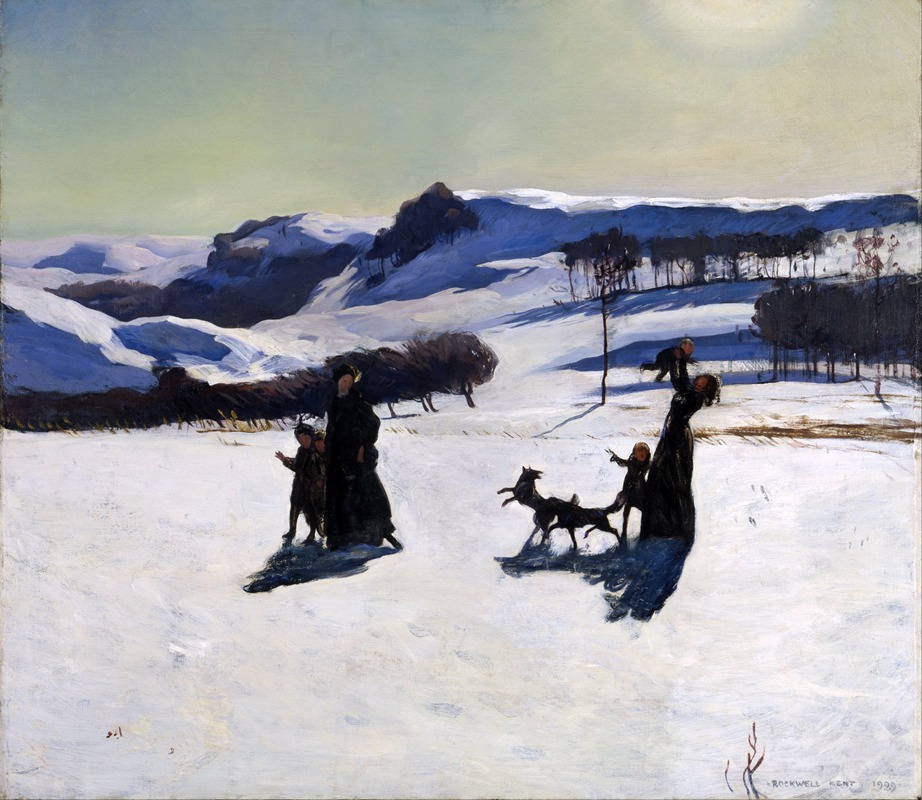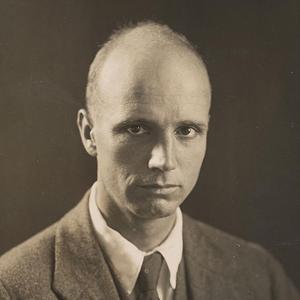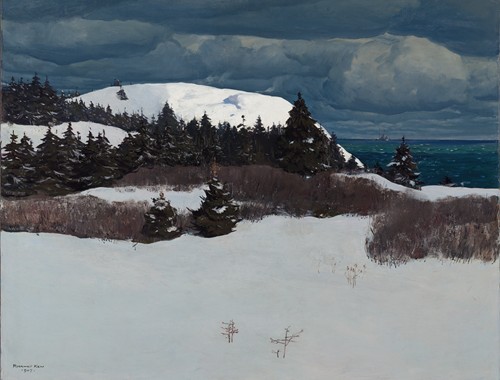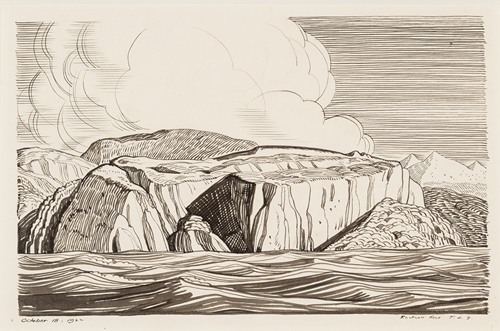

Rockwell Kent was an American painter, printmaker, illustrator, writer, sailor, adventurer and voyager.
Rockwell Kent was born in Tarrytown, New York. Kent was of English descent. He lived much of his early life in and around New York City, where he attended the Horace Mann School. Kent studied with several influential painters and theorists of his day. He studied composition and design with Arthur Wesley Dow at the Art Students League in the fall of 1900, and he studied painting with William Merritt Chase each of the three summers between 1900 and 1902 at the Shinnecock Hills Summer School of Art, after which he entered in the fall of 1902 Robert Henri's class at the New York School of Art, which Chase had founded. During the summer of 1903, in Dublin, New Hampshire, Kent was apprenticed to painter and naturalist Abbott Handerson Thayer. An undergraduate background in architecture at Columbia University prepared Kent for occasional work in the 1900s and 1910s as an architectural renderer and carpenter. At Columbia, Kent befriended future curator Carl Zigrosser, who became his close friend, supporter, and collaborator.
Kent's early paintings of Mount Monadnock and New Hampshire were first shown at the Society of American Artists in New York in 1904, when Dublin Pond was purchased by Smith College. In 1905 Kent ventured to Monhegan Island, Maine, and found its rugged and primordial beauty a source of inspiration for the next five years. His first series of paintings of Monhegan were shown to wide critical acclaim in 1907 at Clausen Galleries in New York. These works form the foundation of his lasting reputation as an early American modernist, and can be seen in museums across the country, including the Metropolitan Museum of Art, Seattle Art Museum, New Britain Museum of American Art, and the Fine Arts Museums of San Francisco. Among those critics lauding Kent was James Huneker of the Sun, who praised Kent's athletic brushwork and daring color dissonances. (It was Huneker who deemed the paintings of The Eight as "decidedly reactionary".) In 1910, Kent helped organize the Exhibition of Independent Artists, and in 1911, together with Arthur B. Davies he organized An Independent Exhibition of the Paintings and Drawings of Twelve Men, referred to as "The Twelve" and "Kent's Tent". Painters Marsden Hartley, John Marin, and Max Weber (but not John Sloan, Robert Henri, or George Bellows) participated in the 1911 exhibition.
A transcendentalist and mystic in the tradition of Thoreau and Emerson, whose works he read, Kent found inspiration in the austerity and stark beauty of wilderness. After Monhegan, he lived for extended periods of time in Winona, Minnesota (1912–1913), Newfoundland (1914–15), Alaska (1918–19), Vermont (1919–1925), Tierra del Fuego (1922–23), Ireland (1926), and Greenland (1929; 1931–32; 1934–35). His series of land and seascapes from these often forbidding locales convey the Symbolist spirit evoking the mysteries and cosmic wonders of the natural world. "I don't want petty self-expression", Kent wrote, "I want the elemental, infinite thing; I want to paint the rhythm of eternity."
In the late summer of 1918, Kent and his nine-year-old son ventured to the American frontier of Alaska. Wilderness (1920), the first of Kent's several adventure memoirs, is an edited and illustrated compilation of his letters home. The New Statesman (London) described Wilderness as "easily the most remarkable book to come out of America since Leaves of Grass was published." Upon the artist's return to New York in March 1919, publishing scion George Palmer Putnam and others, including Juliana Force—assistant to Gertrude Vanderbilt Whitney—incorporated the artist as "Rockwell Kent, Inc." to support him in his new Vermont homestead while he completed his paintings from Alaska for exhibition in 1920 at Knoedler Galleries in New York. Kent's small oil-on-wood-panel sketches from Alaska—uniformly horizontal studies of light and color—were exhibited at Knoedler's as "Impressions." Their artistic lineage to the small and spare oil sketches of James Abbott McNeill Whistler (1834–1903), which are often entitled "Arrangements," underscores Kent's admiration of Whistler's genius.
Approached in 1926 by publisher R. R. Donnelley to produce an illustrated edition of Richard Henry Dana, Jr.'s Two Years Before the Mast, Kent suggested Moby-Dick instead. Published in 1930 by the Lakeside Press of Chicago, the three-volume limited edition (1,000 copies) filled with Kent's haunting black-and-white pen/brush and ink drawings sold out immediately; Random House also produced a trade edition.
Less well known are Kent's talents as a jazz age humorist. As the pen-and-ink draftsman "Hogarth, Jr.," Kent created dozens of whimsical and smartly irreverent drawings published by Vanity Fair, New York Tribune, Harper's Weekly, and the original Life. He also brought his Hogarth, Jr., style to a series of richly colored reverse paintings on glass that he completed in 1918 and exhibited at Wanamaker's Department Store. (Two of these glass paintings are in the collection of the Columbus Museum of Art, part of the bequest of modernist collector Ferdinand Howald.) In Rockwell Kent: The Mythic and the Modern, Jake Milgram Wien devotes an entire chapter to Hogarth, Jr. and reproduces several of the ink drawings and reverse paintings on glass. Kent frequently crossed into the realm of illustration in the 1920s and contributed drawings for reproduction on the covers of many leading magazines. For example, Kent's pen, brush, and ink drawings were reproduced on the covers of the pulp magazine Adventure in 1927, leading Time magazine to say that "if it were distinguished for nothing else, Adventure would stand apart from rival 'pulps' ... because it was once entirely illustrated by Rockwell Kent ..." Decorative work ensued intermittently: in 1939, Vernon Kilns reproduced three series of designs drawn by Kent (Moby Dick, Salamina, Our America) on its sets of contemporary china dinnerware.
At the Art Students League in the 1920s or 1930s, Kent met and befriended many artists, including Wilhelmina Weber Furlong and Thomas Furlong.
Raymond Moore, founder and impresario of the Cape Playhouse and Cinema in Dennis, Massachusetts, contracted with Rockwell Kent for the design of murals for the cinema--including an extraordinarily expansive mural for the ceiling. The work of transferring and painting the designs on the 6,400-square-foot (590 m2) span was done by Kent's collaborator Jo Mielziner (1901–1976) and a crew of stage set painters from New York City. Ostensibly staying away from the state of Massachusetts to protest the Sacco and Vanzetti executions of 1927, Kent did in fact venture to Dennis in June 1930 to spend three days on the scaffolding, making suggestions and corrections. The signatures of both Kent and Mielziner appear on opposite walls of the cinema.
In 1927, Kent moved to upstate New York where he had acquired an Adirondack farmstead. Asgaard, as he named it, was his residence for the remainder of his life, and from his studio there he worked tirelessly on countless painting and drawing assignments. In the summer of 1929, Kent sailed on a painting expedition to Greenland, and his adventures (and misadventures) are recounted in the best-selling N by E (1930). After meeting Danish Arctic explorers Peter Freuchen and Knud Rasmussen on this trip, Kent determined to return to Greenland to paint and write. He spent two years (1931–32 and 1934–35) above the Arctic Circle in a tiny fishing settlement called Igdlorssuit (or Illorsuit), where he conceived some of the largest and most celebrated paintings of his career. Among his many cross-cultural encounters in Greenland was with Leni Riefenstahl, the famed German filmmaker/actor, who was briefly in Illorsuit with the film crew of S.O.S. Iceberg. Kent's own movie-making aspirations, including a quasi-documentary film featuring the Inuit, are documented in Rockwell Kent and Hollywood (Jake Milgram Wien, 2002), cited below. Many of Kent's historic photographs and hand-tinted lantern slides are reproduced for the first time in North by Nuuk: Greenland after Rockwell Kent (Denis Defibaugh, 2019), also cited below.
As World War II approached, Kent shifted his priorities, becoming increasingly active in progressive politics. In 1937, the Section of Painting and Sculpture of the U.S. Treasury commissioned Kent, along with nine other artists, to paint two murals in the New Post Office building at the Federal Triangle in Washington, DC; the two murals are named "Mail Service in the Arctic" and "Mail Service in the Tropics" to celebrate the reach of domestic airborne postal service. Kent included (in an Alaska Native language and in tiny letters) a polemical statement in the painting, apparently a message from the indigenous people of Alaska to the Puerto Ricans, in support of decolonization. As translated, the communication read "To the peoples of Puerto Rico, our friends: Go ahead, let us change chiefs. That alone can make us equal and free". The incident caused some consternation.
Kent's patriotism never waned in spite of his often critical views of American foreign policy and his impatience with the promises of capitalism. He remained America's premier draftsman of the sea, and during World War II he produced a series of pen/brush and ink maritime drawings for American Export Lines and began another series of pen/brush and ink drawings for Rahr Malting Company which he completed in 1946. The drawings were reproduced in To Thee!, a book Kent also wrote and designed celebrating American freedom and democracy and the important role immigrants play in constructing American national identity. In 1948, Kent was elected to the National Academy of Design as an Associate member, and in 1966 he became a full Academician. Kent passed away at his home in the Adirondacks in 1971.


